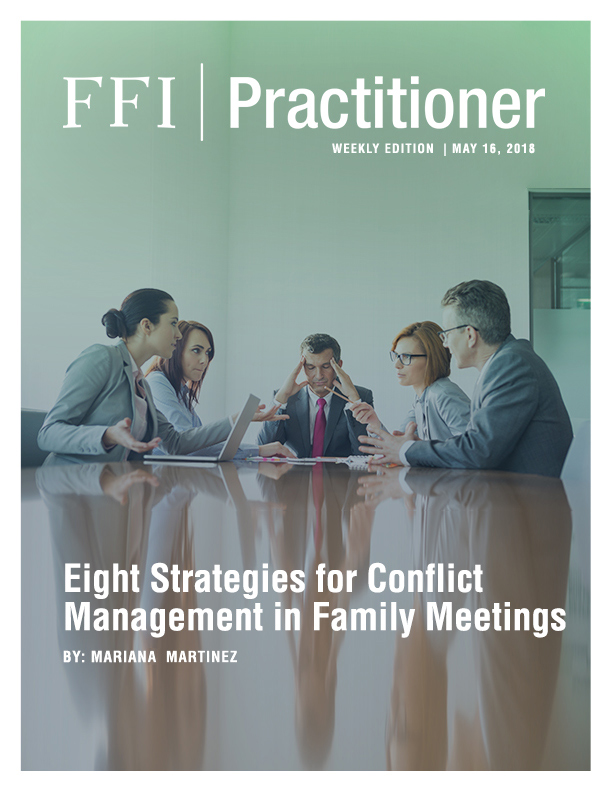

From FFI Practitioner
Thanks to Mariana Martinez, a member of the FFI IberoAmercian Virtual Study Group, for this article entitled, “Eight Strategies for Conflict Management in Family Meetings.” You have your choice of reading it in English or in Spanish! More articles from this group will be forthcoming. We appreciate their taking the lead in helping us publish in two languages!
Conflict is defined as opposition or disagreement.1 It arises when, in the face of difference of opinion, individuals try to change the feelings, thoughts, or behaviors of others. Conflict also arises when someone is not receiving something he or she needs (or thinks he needs or deserves), and attempts to make others respond to this need, sometimes by coercion or even by force.
All families experience increased tension when they are under pressure. A relaxed family is a very different organism than a tense family. When stress is high, people’s capacity for thinking in a clear, deliberate, and flexible fashion diminishes and conflict emerges more easily. A relaxed family is less vulnerable to conflict and more capable of making better decisions.2,3
When conflict arises during family meetings, it is important for the consultant to know how to manage everyone’s intense emotions and to help the family regain a mindset more conductive to reflection and productive dialogue. He or she needs to make sure the conflict does not become an obstacle for achieving the objectives set for the meeting. Differences of opinion, opposing points of view, and even heated discussions are not the problem. The problem is when the emotions that surface obstruct the capacity of the family to find solutions.

Strategies that can help reduce tension during family meetings:
- Modulate emotional reactivity. Human beings are very sensitive to perceived signals from others, especially from family members. A look, certain body postures, physical proximity/distance, and the tone of voice are often interpreted as threats. Threats generate immediate emotional reactions4 that might lead to conflict. To help manage reactivity, the consultant may request that the participants address their statements to the consultant, minimizing direct interaction between family members. After listening to one person and asking questions to clarify and expand on her opinion, the consultant moves to the next person. This generates a dialogue between the consultant and each family member while the others observe. The consultant might ask someone to share what thoughts they had as they listened to the others.5 This structure allows the person who is talking to better articulate her thoughts, while allowing others to listen and consider what is being said without worrying about providing an immediate response. The interaction tends to lead to a more thoughtful and less reactive discussion.
- Change the focus of attention. When a topic generates too much tension, reactivity increases and people predictably raise their voices, attack, blame, or disengage. When this crisis point is reached, it is recommended to change the focus of attention for a few minutes. This can be done by asking questions about aspects related to the topic but that carry less emotional weight.6 This technique allows people to regulate reactivity levels and to return more calmly to the matter at hand.
- Maintain a broad view of the problem. When emotions dominate our thinking, complex realities tend to be simplified. Simplification is a mechanism that helps in situations when rapid decisions are required, especially in dangerous situations, but it is less effective when dealing with complex matters. This is described as “tunnel vision” problem solving, and it focuses on certain pieces of information while ignoring others. Therefore, this approach is not conducive to considering various factors simultaneously and to contemplating long-term consequences.7 The consultant, by asking broad questions, invites the family to take a wider perspective and examine multiple aspects of the problem under discussion. Questions such as, “How did the problem come about and in what context?” “Who is involved in decision making?” and “What is the impact of one decision versus another for individuals or groups?” address the matter with a sense of perspective and avoid oversimplification, which in turn can reduce the tension of the moment.
- Concentrate on facts. When people’s perception of realty is dominated by subjectivity, they are more prone to conflict. If the consultant concentrates on facts rather than on interpretations of those facts (such as speculation about others’ intentions and motives), it is easier for discussions of sensitive topics to remain more objective.8
“When conflict arises, the consultant is required to know how to manage emotional processes during family meetings, such that the family may regain a state conducive to reflection.”

- Recognize feelings but do not focus on them. Feelings are a good source of information about what is happening within oneself and in relationships. Negative feelings (such as anger, guilt, or sadness) dominate during interpersonal conflict. Ignoring feelings generates more irritation, and concentrating on feelings tend to exacerbate them. Identifying feelings in the moment, naming them, and holding space for expressing them is important. Likewise, it is important to ensure that family members don’t get lost in the emotionality but instead maintain their critical thinking skills.9 For example, the consultant might say, “I see you don’t feel appreciated for your work in the business, and that it is hurtful to you. When did you begin to feel this way?” or “You feel angry and feel that what happened was unfair. Who else in the family do you think feels angry too?” These types of questions recognize and validate the person’s experience while pushing to continue productive exploration by stimulating the thinking process.
- Show interest in the situation and in the family. A genuine attitude of curiosity on the part of the consultant invites members of the family to move from frustration to an attitude of interest. Interest contributes to activating the thought processes conducive to problem solving. If the consultant shows interest in understanding how differences evolved, what are they about, and who thinks similarly or differently from others, then his or her energy is dedicated to expanding the family’s views rather than to changing another’s perspective. This changes the tone of a meeting and makes it more productive.10
- Keep the objectives of the family in mind. During a family meeting, if the consultant notices that the conversation is beginning to digress from the subject at hand and that conflict is arising, one way to return to a more productive dialogue is to bring up the objectives that the family set up for that meeting. Referring to the objectives that brought them together is a quick way to redirect the family.
- Promote individuality. This recommendation seems contrary to reaching a consensus, but it is not. A conversation in which individuals can express their own opinions, one that allows the coexistence of divergent points of view, is the first step to forming consensus. Sometimes conflict emerges in the family because positions have more to do with reacting against another person rather than with advancing a true conviction. The consultant can create the space for participants to move away from this reactivity by asking them to think about their personal perspectives, perhaps by writing them down, before sharing them. Once participants are clear about their own thinking, they can contrast it with the thinking of others. Then the conversation can become more about ideas than about the people involved.

The Group extends FFI’s core mission by focusing on education and multidisciplinary learning. The Group seeks a multidisciplinary composition to broaden and enrich the learning experience of its members. A geographic mix is also a priority.
References
2 Shields, G., Sazma, M., Yonelinas, A. (2016). The Effects of Acute Stress on Core Executive Functions: A Meta Analysis and Comparison with Cortisol. Neuroscience and Biobehavioral Review. Sep, 68: 651-668.
3 Center for the Developing Child Harvard University (2016). Building Core Capabilities for Life. The science Behind the Skills Adults Need to Succeed in Parenting and in the Workplace. Center on the Developing Child. Harvard University. Retrieved from: https://46y5eh11fhgw3ve3ytpwxt9r-wpengine.netdna-ssl.com/wp-content/uploads/2016/03/Building-Core-Capabilities-for-Life.pdf
4 Tate, A. re (2018). 10 Scientific Reasons People are Wired to Respond to Your Visual Marketing. Retrieved from: https://www.canva.com/learn/visual-marketing/
5 Martinez, M. (2015). Aplicaciones Clínicas de la Teoría de Bowen. En: Rodriguez, M., Martínez, M. (Eds.), La Teoría Familiar Sistémica de Bowen: Avances Aplicación Terapeútica. (pp.155-178). Madrid: McGraw-Hill.
6 See, J., MacLeod, C., & Bridle, R. (2009). The reduction of anxiety vulnerability through the modification of attentional bias: A real-world study using a home- based cognitive bias modifcation procedure. Journal of Abnormal Psychology, 118(1), 65.
7 Kahneman, D. (2011). Thinking, Fast and Slow. New York: Farrar, Straus and Giroux.
8 Gilbert, R. (1992) Extraordinary Relationships. A New Way of Thinking About Human Interactions. New York: John Wiley & Sons.
9 Ochsner, K.N., Bunge, S.A., Gross, J.J y Grabriele, J.D.E. (2005). Rethinking Feelings; an fMRI Study of the Cognitive Regulation of Emotion. En: J.T. Cacciopo y G.G. Berntson (Eds.), Social Neuroscience: Key Readings (pp.253-270). New York: The Psychology Press.
10 Martínez, M. (2015)
About the contributor



